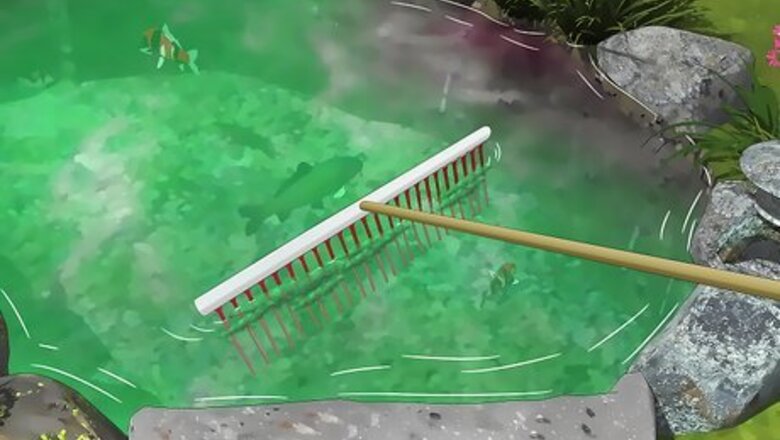
views
Rake out the algae.

This is the simplest solution to safely remove algae. Just grab a rake or skimming tool and manually remove as much algae as you can from the surface of the water. If your pond has a rubber pond liner, use a plastic rake to avoid accidental tears (a metal rake can be used with a concrete liner). Raking works best on string or matted algae (string algae looks like long green hair, and matted algae looks like a spongy mat of string algae). Take care not to bump any fish near the surface with your rake. Otherwise, they’ll remain safe and sound! To manually remove algae from a rock or pond wall, scrub the algae off with a firm brush (avoid wire brushes so you don’t scratch your rocks). This is a short-term solution that doesn’t prevent more algae from growing back.
Add barley straw to your pond.
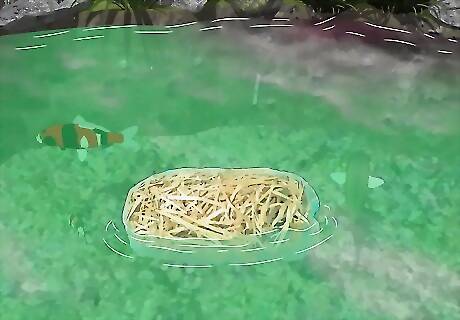
Barley straw clears up existing algae and prevents new growth. Buy straw from a farm-supply or feed store (it’s more economical than buying online). Submerge a bundle of it in the pond and let it float around near the center. As the straw breaks down it releases organic compounds that kill algae. 8 ounces (230 g) of barley straw can treat about 1,000 gallons (3,800 L) of water. For smaller ponds, buy a mini-bale, pellet, or liquid version of barley straw. Research suggests this works better for green algae (a pea-soup looking algae caused by microscopic plankton) than string or matted algae. Barley straw is organic and eco-friendly—perfect for ponds with fish in them.
Use a beneficial bacteria tablet.
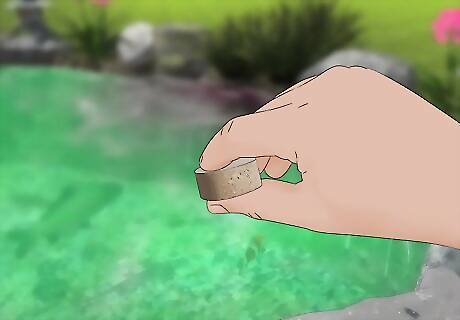
Certain bacteria eat decaying debris and take nutrients away from algae. Beneficial bacteria tablets are available at most pet stores and are fish-friendly. Place a tablet in your pond (on a plant or a rock) and let the little bacteria do their job. There are lots of different beneficial bacteria brands and products, so read the packaging for instructions on how much and how often to apply. A 1 ounce (28 g) tablet works for 1,000 gallons (3,800 L) of pond water. An initial dose in the spring will help prevent algae growth in the first place. Monthly or bi-weekly maintenance doses are usually recommended. This works best in smaller ponds and is more effective when paired with an aeration system.
Install an aerator or fountain.
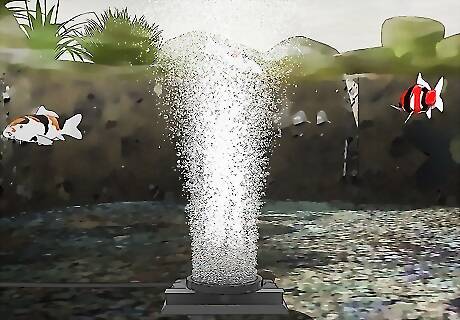
Aerators and fountains stimulate bacteria that break down organic matter. This means that less nutrients will be left floating around in the pond (AKA, no food for the algae). They also push oxygen deeper into the water to nourish your fish and counteract the carbon dioxide that can build up under algae growth. Aerators and fountains are available at most home improvement stores. This method will need more maintenance than others and is an added electricity expense.
Buy a UV sterilizer.
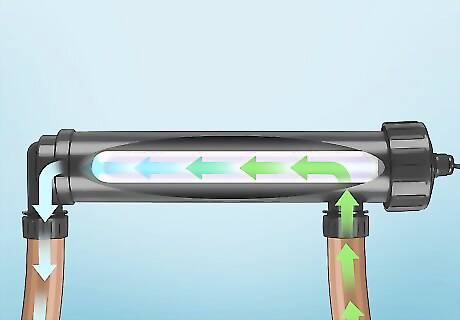
Ultraviolet light kills microscopic green or planktonic algae. A pet store sterilizer only generates enough UV rays to kill free-floating algae, so it’s harmless to your fish. Your pond may look brown or gray as the algae dies and decays, but it will eventually settle out and your water will be crystal clear. UV bulbs need to be replaced every 6-12 months (they get weaker over time). UV treatments work best in clear water. Install it in springtime before the algae blooms or clear out as much algae as you can with other methods beforehand. Don’t use a water clarifier to clean up the dead algae during your UV treatment since clarifiers can clump fishes’ gills together.
Add hydrogen peroxide (H2O2) to the water.
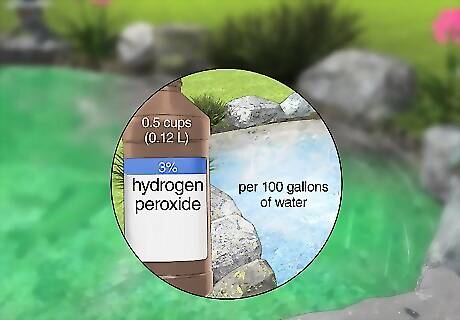
Hydrogen peroxide damages algae and breaks down into water and oxygen. It’s completely safe for fish when you use the correct amount (0.5 cups (0.12 L) of 3% H2O2 per 100 gallons (380 L)). It can damage fish gills if it comes in direct contact, so pour it away from any fish and stir the water to mix it in. H2O2 is a more recently discovered anti-algae method. Copper salts are more traditional and can be fish-friendly, but are lethal when used incorrectly.
Dye the water blue.
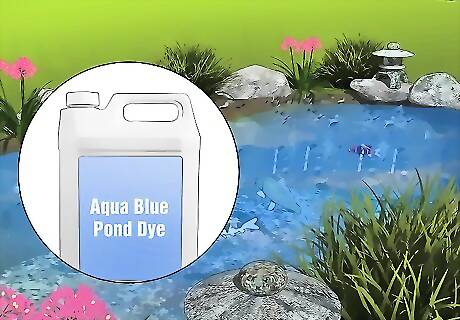
Aquatic dyes block the algae from sunlight and slow their growth. Blue is the most common dye—it’s harmless to fish and animals, but blocks the blue light algae needs. It works best if you apply it in the spring before an algae bloom and reapply during the summer according to the instructions. Aquatic pond dye can be found at most home improvement or pond shops. The amount you need depends on the volume of your pond (check the label of the dye to see how much water a bottle can treat). Adding dye makes it harder to view fish and frogs in your pond than in clear water. Blue dye is most effective at countering green and planktic algae.
Shade your pond with floating plants.
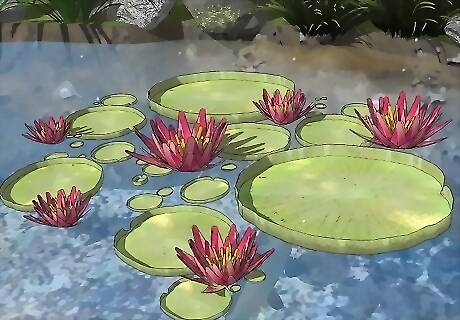
Adding more plants will take away resources algae needs to survive. Plants like water lilies, fanwort, or watercress take away nutrients from algae and block sunlight from entering the water. Without food or light, algae can’t continue to grow. After a few weeks, your water will clear up and you’ll have some beautiful plants to look at, too. Add enough plants so that 50 to 70% of the pond surface is covered. Pond-loving plants are available at gardening stores and nurseries. Ask about which plants grow best in your climate. Add extra shade with umbrellas or sun sails around the sides of your pond.
Limit extra fish food in the water.
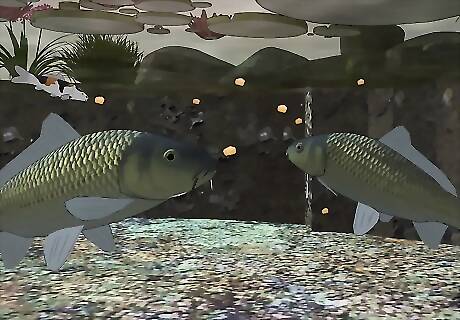
Overfeeding your fish is a huge contributor to algae growth. When uneaten food decays, it releases nitrates and phosphates—algae’s favorite food! To avoid this, only feed your fish as much as they can stomach in about 5 minutes. As soon as you notice they stop nibbling, stop feeding. Getting your fish on a consistent eating schedule can help reduce wasted or uneaten food. When temperatures are consistently below 45 °F (7 °C), stop feeding your fish. Their metabolism slows way down in winter and they can live off of whatever organic matter is already in the water.
Keep your pond debris-free.
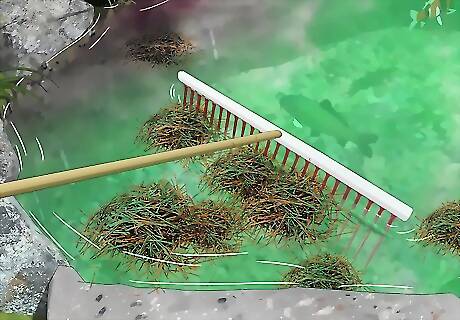
When leaves or twigs decay, they become great food for algae. Regularly clearing your pond of rotting organic matter cuts the algae off from a major food source. Use a rake, net, or skimming tool to manually remove unwanted debris from the surface. Go slowly and carefully to avoid bumping any fish. Siphon matter from the bottom of the pond away with a pond vacuum, still making sure to move slowly so you don’t spook the fish.
Build a buffer around your pond.
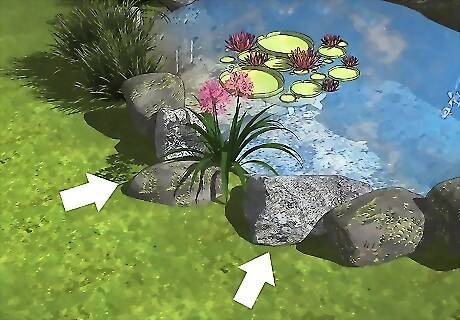
A buffer blocks rain runoff from carrying nutrients into your pond. This will starve your algae by blocking their food supply. Create a wall of plants or a short (no more than 2 inches (5.1 cm) tall) stone or brick rim all around your pond. You can leave a few openings to access the water if you like, but it should be mostly surrounded. Buffers are completely fish-safe and add a nice decorative element to your pond, too. Using plants as a border will attract all sorts of beautiful butterflies and birds to your pond. A border will also stabilize the shore of your pond and prevent erosion over time.
















Comments
0 comment